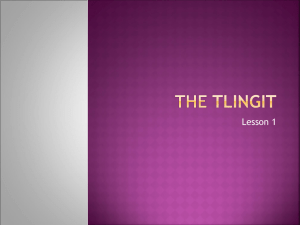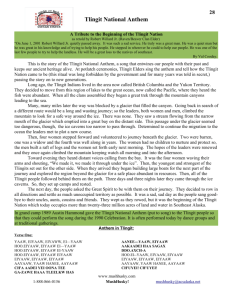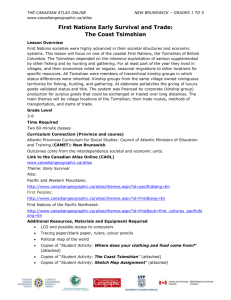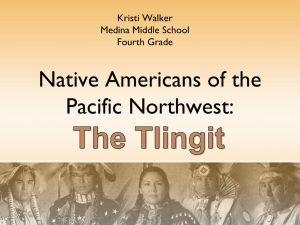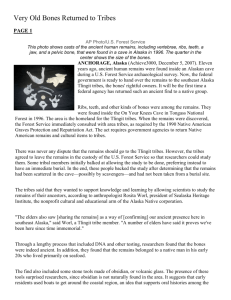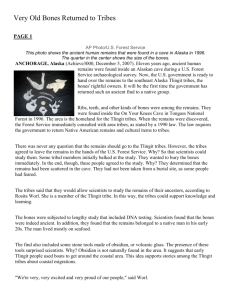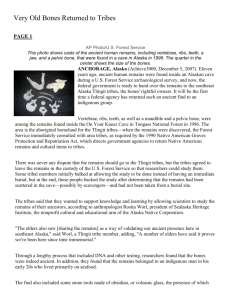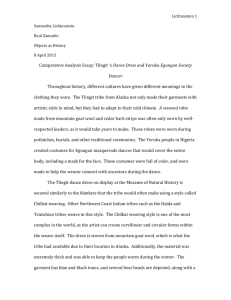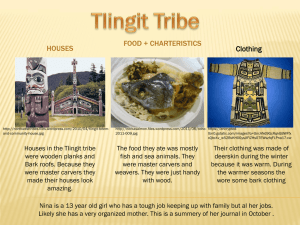Weaving Traditional Ecological Knowledge
advertisement
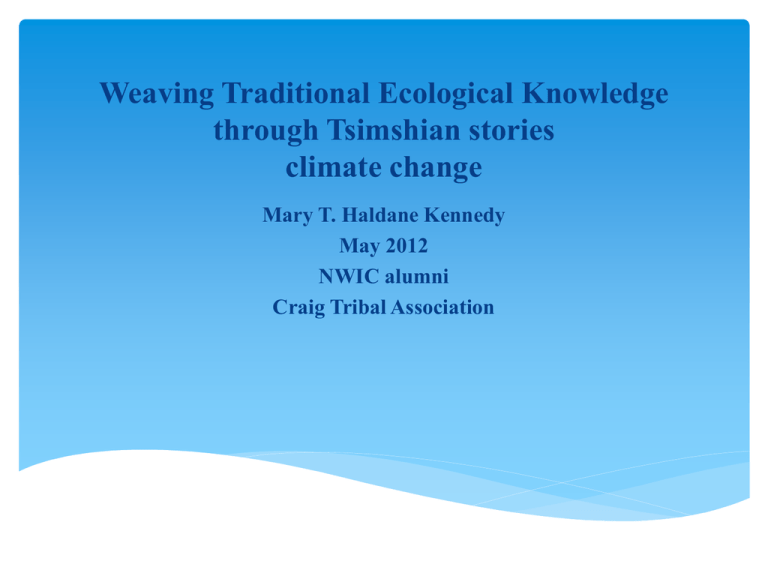
Weaving Traditional Ecological Knowledge through Tsimshian stories climate change Mary T. Haldane Kennedy May 2012 NWIC alumni Craig Tribal Association Sm’algyax introduction (explain Tsimshian protocol) Holly Churchill and I met at a meeting about weavers and funding available through the State of Alaska , she was insistent about doing projects for utilitarian purposes this eventually led up to my questions I had for this research. My main questions in this research project How did Tsimshian/Haida/Tlingit people teach about issues pertaining to our environment? As a traditional Tsimshian weaver, I have heard stories and at first thought all our stories were pertaining to our weaving, only to find in my research, the method of storytelling was the main focus. Tlingit and Tsimshian http://www.ankn.uaf.edu/ANCR/Southeast/TlingitMap/ Tlingit map Tlingit territory Tsimshian territory Figure 1. http://www.ankn.uaf.edu/ANCR/Southeast/TlingitMap/ The location of the Tribes/Clan/House is very important. Ayaax How was the information passed down? Storytelling We used this method In all aspects of our lives This included our traditional Art and carving We learned it formally And informally-in weaving classes and at home Adawx Tsimshian used this method It belonged to our tribes/clans/houses It literally tanslates to “true story” Or “true account” More about what I know My teacher Stikine River-Cultural connections Chief Shakes Dustin Johnsons explained our cultural ties This is a story about the connection of the Northern Tlingit of Wrangell and Tsimshian of British Columbia Figure 3 http://www.civilization.ca/cmc/exhibitions/aborig/tsimsian/menfi01e.shtml Fish traps “The Haida had names for their fish traps and the Tlingit attached carved figures to the tops of the posts used in the structures.” (111, Stewart) This is something that I have learned from numerous elders too. What was documented? Last story about our people moving from Metlahkatlah British Columbia to Metlakatla Alaska How do we use this method today The Tsimshian people used the adawx as a format to teach many things, in general it dealt with Environmental Issues. These came about mostly at our yaokw (potlatch) Or at a formal setting. The stories, belong to each tribe/clan/house some were made public and others shared within the family only. Today things are much different our politics and ideals changed. The stories documented in 1910 http://archive.org/details/tsimshianmytholo00boas Who is Boas? What contribution did he make to ensuring that we passed down information pertaining to our Envirionment, some of the stories there talk about clans and their ties to the land. How can we use the Adawx to deal with issues of Climate change? Today, we share stories about events in our lives, is the “adawx” something we can use given all the changes in the political aspect. Today, we are governed differently and we no longer rely on the previous structure, yet it still exists. The answer to the original questions what method was used to teach, how can it be used today Although my original idea was that only the weavers of the Tsimshian people used stories, I was wrong. Our adawx was used in all aspects of the lives with the ayaax in mind. All of the decisions were to keep in mind, the responsibility to explain our surroundings and how to not merely survive but Thrive in a very challenging setting. The stories we hear today will be a part of a changing environment. Who determines what is included. In the past the very complex set up of the political structure has changed. What was documented change? What are the spiritual aspects of this change i.e. the migration of 807 people from Old Metlakatla to new Metlakatla. Although we may have a different setting it is important to hang onto the protocol of how the Tsimshian people used the “adawx” recognize that aspects of our culture was maintained even though the political structure changed. Looking at the neighboring tribes, we know that there are stories that exist regarding to how tribes dealt with “Climate change” An example of this is the Whale house Yaay-Hit of the Tlingit people who moved from an area in Northern British Columbia to the area north of Juneau, Alaska. At a recent summit for climate change issues this story of how they moved was shared by a Tlingit elder. Works cited Canada. (2010, April/May 30). Canadian Museum of Civilization [Online exhibition]. Retrieved from http://www.civilization.ca/cmc/exhibitions/aborig/fp/fpz2c01e.shtml Canadian Museum exhibition. (2005, May/June 19). Tsimshian society and culture [online exhibition]. from http://www.civilization.ca/cmc/exhibitions/aborig/tsimsian/menfi01e.shtml Retrieved Hope III, A. (2006, August/September 16). Tlingit Tribes, Clans and Clan Houses. Retrieved from http://www.ankn.uaf.edu/ANCR/Southeast/TlingitMap/ Johnson, D. (2004, Spring). Cultural ties of the Tlingit and Tsimshian Killer whale clans. Personal presented at Phone conversation, Alaska , British Columbia. interview How do we use this method to deal with Climate change issues today? Questions I sent to the IGAP workers They were addressing the climate change in our environment -the changes include invasive species and species that will disappear Acknowledgements I would like to thank Joel Green for his guidance in this research project. I would like to thank my teachers, Deloris Churchill and her daughter Holly, who taught me there is more to weaving than just art and our stories All my teachers that I learned stories from, Evelyn Littlefield, Violete Booth, Cissy Guthrie, Arnold Booth
